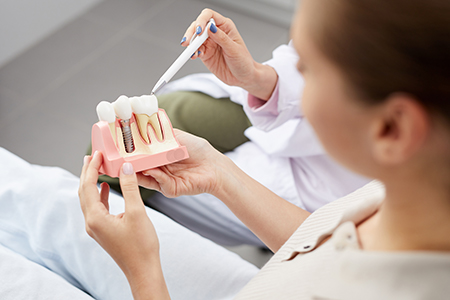

Losing one or more teeth changes more than just the way your smile looks — it alters how you chew, speak, and how the jawbone supports your facial structure. Dental implants are designed to replace the entire missing tooth structure, anchoring a prosthetic tooth to the jaw with a small, biocompatible post. Because implants restore the root as well as the crown, they preserve chewing efficiency and help maintain the bones and tissues that shape your face.
Modern implant systems are precise and well-documented clinically. When planned and placed correctly they provide stable, long-term support for single crowns, bridges, and full-arch restorations. For many patients, implants mean a return to normal eating habits, clearer speech, and the ability to smile without worrying about slippage or discomfort.
Choosing implant therapy is a partnership between patient and provider. Your anatomy, overall health, oral hygiene, and long-term goals guide treatment choices. At Silk Dental Delray Beach (formerly Marc Bilodeau DMD), we prioritize conservative, evidence-based approaches that aim to protect healthy tissue while delivering dependable, natural-looking results.

At its core, a dental implant is a small surgical post, typically made of titanium or a titanium alloy, that acts like an artificial tooth root. Because these materials are biocompatible, they bond with bone through a process called osseointegration. Once integrated, an implant behaves much like a natural root, transferring chewing forces into the jawbone and providing a secure base for restorations.
Beyond the metal post, an implant restoration includes an abutment and a crown or prosthesis. The abutment joins the implant to the visible tooth replacement and can be customized to match your bite and esthetic needs. The final crown or bridge is crafted to blend with the surrounding teeth — matching color, shape, and texture for a cohesive appearance.
Long-term success depends on multiple factors: the quality and quantity of jawbone, the position of the implant, healthy gum tissue, and consistent oral hygiene. Advances in imaging and surgical guides allow clinicians to plan placement with remarkable accuracy, reducing risk and improving outcomes for most candidates.
Implant dentistry is versatile. A single missing tooth is often best replaced with a single implant and crown, restoring the tooth without altering adjacent teeth. For patients missing several teeth in a row, implant-supported bridges allow replacement of multiple teeth while preserving neighboring natural teeth and stimulating the jawbone in the edentulous area.
When many or all teeth are missing, full-arch solutions supported by four to six implants can recreate a stable, fixed set of teeth. These full-arch restorations remove the need for removable dentures, improve bite strength, and restore facial support. Implant-retained overdentures are another option: a denture snaps onto implants for added retention while remaining removable for cleaning when desired.
Selecting the right option depends on your anatomy, functional needs, and cosmetic preferences. Diagnostic records, including 3D imaging when appropriate, allow the care team to match a treatment plan to your oral health situation and lifestyle goals.
Successful implant care begins with careful planning. A complete evaluation reviews your medical history, oral health, bite relationship, and bone volume. Imaging — from panoramic X-rays to cone-beam CT scans when needed — helps determine implant locations and whether supplemental procedures such as bone grafting are required to create a stable foundation.
Surgery to place implants is typically performed in the dental office on an outpatient basis. The procedure can be done using local anesthesia and, if desired, conscious sedation to ensure comfort. Depending on the case, a temporary restoration may be placed immediately, or a healing period of several months may be recommended to allow for robust osseointegration before the final prosthetic is attached.
Throughout treatment you’ll receive clear pre- and post-operative instructions, and we’ll discuss pain control, activity restrictions, and follow-up care. Regular check-ups during the healing phase help monitor integration and ensure the final restoration is placed with precise fit and function.
Bone loss after tooth extraction or long-term tooth loss is a common challenge; when bone volume is insufficient, grafting procedures can rebuild the jaw so it can support an implant. Bone grafts use carefully selected graft materials and techniques to encourage new bone formation, creating the stable foundation implants need to thrive.

After implants are placed and restored, routine maintenance supports their longevity. Daily brushing and flossing around implant restorations, regular professional cleanings, and periodic evaluations help prevent complications. Unlike natural teeth, implants do not decay, but the surrounding gum and bone can be affected by infection if oral hygiene is neglected.

Smoking, certain medical conditions, and unmanaged gum disease can affect healing and long-term stability. Your care team will review any health factors that may influence treatment and recommend steps to optimize outcomes. With attentive care and routine monitoring, implants offer one of the most durable and predictable methods to rebuild a complete, functioning smile.
Dental implants provide a predictable, long-lasting way to replace missing teeth while preserving jawbone and facial structure. They restore chewing function and confidence, and modern implant dentistry offers solutions for single teeth, multiple gaps, and full-arch replacement. Thorough planning, careful surgical technique, and consistent maintenance are the keys to success.
If you’d like to learn how implant dentistry might apply to your smile, please contact us for more information. Our team can outline potential options and what to expect at each stage of care.
If you've lost a tooth due to injury, decay, gum disease, or any other reason, we recommend dental implants to replace missing teeth. Dental implants come the closest to replicating the look, feel, and function of your natural teeth.
Dental implants are placed into the jawbone and mirror the same function as the root of a tooth. The procedure for dental implants is usually performed while a patient is sedated. Patients who undergo IV sedation must have an empty stomach and transportation home following the procedure. Most sedation patients will have little to no memory of the procedure occurring.
Generally, dental implants are made out of a biocompatible metal such as titanium. Biocompatible metals are also used for other common bone implants (such as shoulder, hip, and knee replacements). The visible portion of the implant is usually made out of porcelain and is custom-made to match your existing teeth.
Dental implants are designed to fuse to the bone, which makes them become permanent fixtures. Typically speaking, the success rate is nearly 100%. There are few cases in which the implant will not fuse as intended and must be removed. If this happens to occur, the procedure can be attempted again a few months later.
Dental implants are not usually covered by dental insurance, but may be covered under a patient's medical insurance. Our office and your insurance company can discuss coverage options with you based on your individual case and treatment plan.
It's easy... just take care of an implant as if it's a natural tooth! This involves regular brushing, flossing, and dental checkups. If you have any concerns about your implant, contact us immediately.
Quick Links